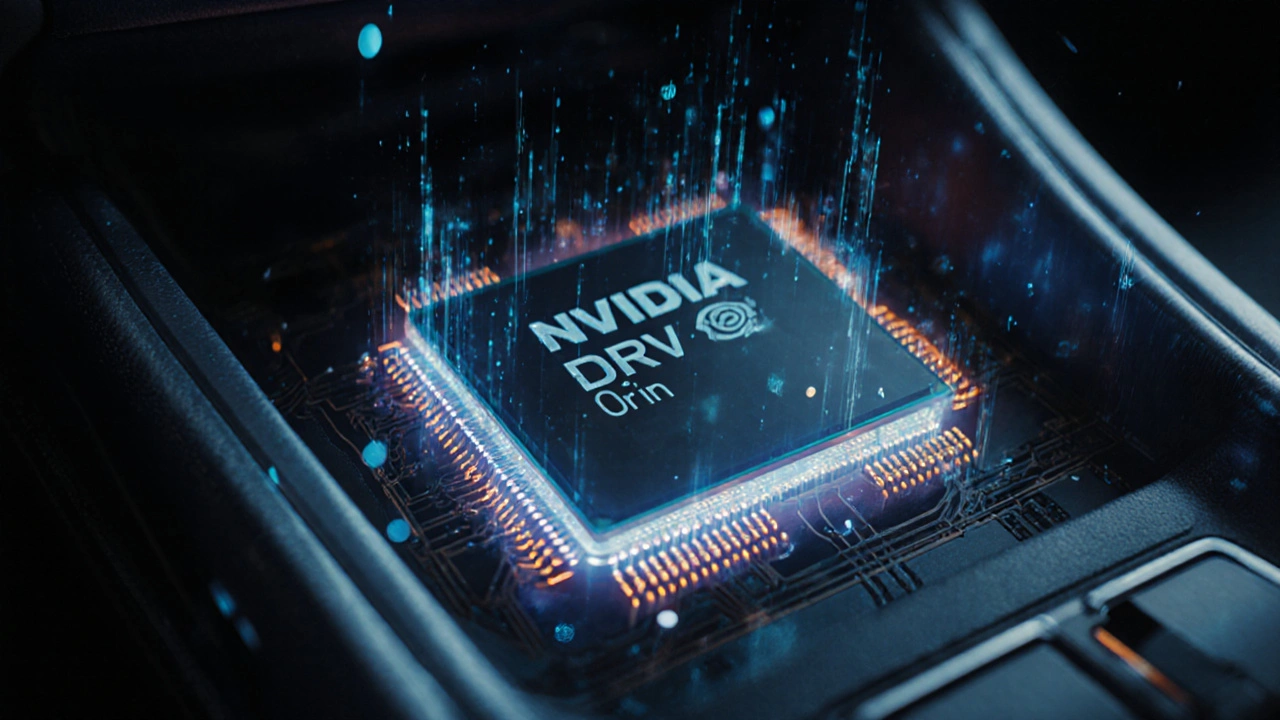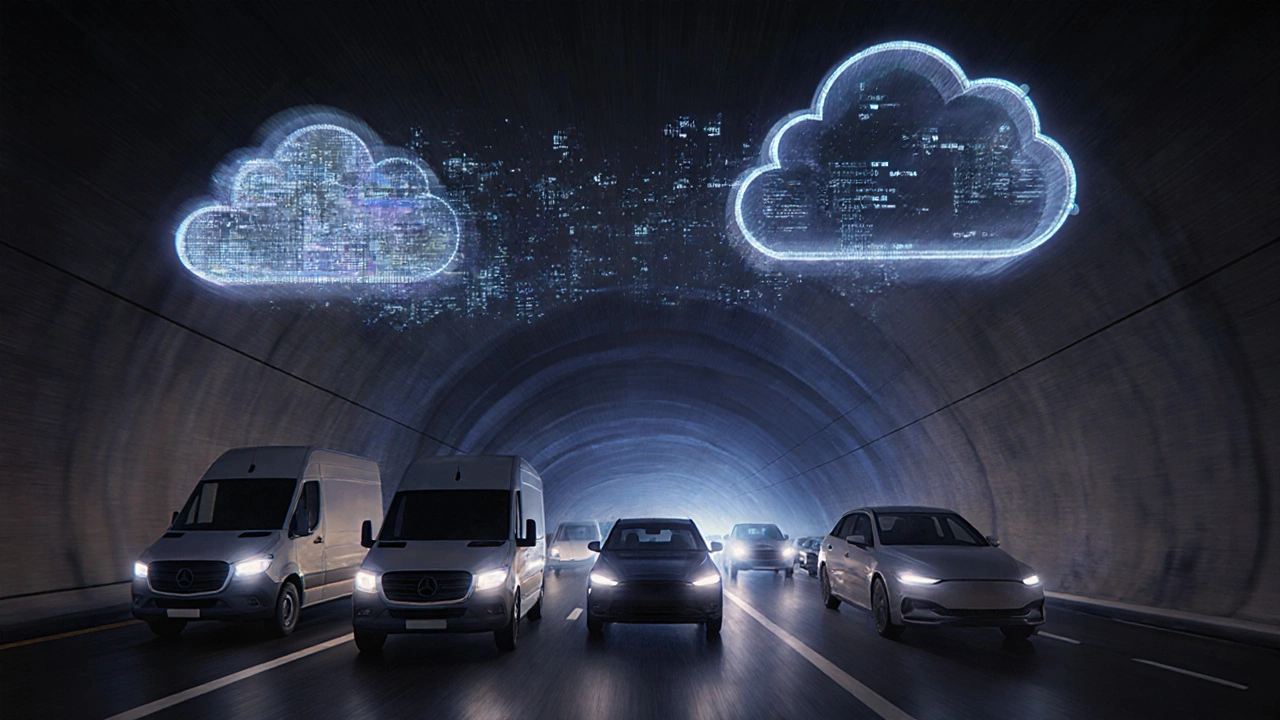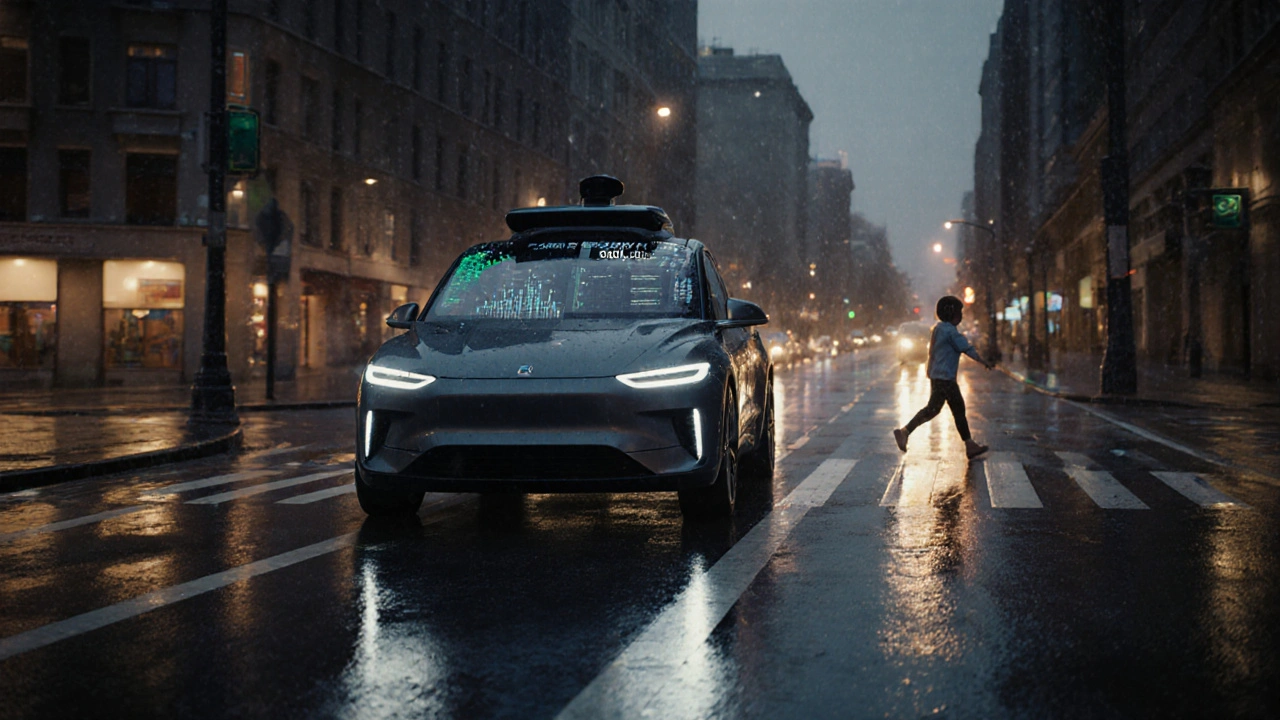When your car detects a pedestrian stepping into the road, it doesn’t wait for a cloud server to tell it what to do. It reacts in milliseconds. That’s edge computing in action-processing data right where it’s generated, inside the vehicle. No delays. No buffering. No lost seconds. And in today’s cars, that speed isn’t just nice to have-it’s the difference between a safe stop and a collision.
Why Latency Kills in Autonomous Driving
Latency is the time it takes for a system to respond. In a smartphone app, a half-second delay might make you tap again. In a self-driving car, that same delay could mean a child is hit. Cameras, radar, lidar, and ultrasonic sensors generate over 4TB of data per hour in a Level 4 autonomous vehicle. Sending all that data to a distant server, waiting for a response, and then acting? That’s too slow.
Edge computing cuts that delay to under 10 milliseconds. For comparison, human reaction time is about 250 milliseconds. Your car is reacting 25 times faster than you can. That’s not science fiction-it’s what Tesla, BMW, and Waymo are already using in their latest models. The data doesn’t leave the car. It’s processed by onboard AI chips like NVIDIA DRIVE Orin or Qualcomm Snapdragon Ride. These chips crunch numbers in real time: is that a plastic bag or a dog? Is the car ahead braking suddenly or just adjusting lane position?
How Edge Processing Works Inside a Car
Think of your car as a mini data center on wheels. At its core are specialized processors that handle sensor input, map data, and vehicle dynamics-all without needing the internet. Here’s how it breaks down:
- Sensors collect data: Cameras spot lane markings, radar tracks distance to other vehicles, lidar builds a 3D map of surroundings.
- Onboard AI processes it: A neural network running on the vehicle’s edge processor identifies objects, predicts movement, and assigns risk levels.
- Action is taken immediately: The car brakes, steers, or accelerates based on local decisions.
- Only summaries are sent to the cloud: After processing, the car sends compressed logs-like “pedestrian detected at 12.3m, avoided by 0.8m”-to update fleet-wide models or trigger maintenance alerts.
This approach reduces bandwidth use by 90% compared to streaming raw video. It also means your car keeps working even when you’re in a tunnel, rural area, or underground parking. No signal? No problem. The decision-making happens right here, inside the car.
Real-World Impact: From Safety to Efficiency
Edge computing isn’t just for self-driving cars. It’s already improving everyday driving. Modern Ford and Hyundai models use edge processing to:
- Adjust automatic emergency braking based on road surface conditions-wet, icy, or gravel-using real-time sensor feedback.
- Optimize engine performance by analyzing exhaust gas data and throttle input locally, cutting fuel use by up to 7%.
- Prevent blind-spot collisions by detecting fast-approaching motorcycles that radar alone might miss.
In fleet operations, companies like UPS and DHL use edge-enabled delivery vans to track package weight shifts, driver behavior, and route efficiency-all without constant cloud connectivity. This reduces downtime and keeps drivers safer.
One study from the University of Michigan’s Transportation Research Institute found that vehicles using edge-based object detection reduced false positives by 62% compared to cloud-reliant systems. Fewer false alarms mean drivers trust the system more-and less likely to disable safety features.

Why Cloud Alone Can’t Handle Vehicle Data
Some companies still try to push everything to the cloud. But here’s the problem: the cloud is too far away.
Imagine a car traveling at 60 mph. In one second, it moves 27 meters. If the system takes 150 milliseconds to send data to a server and get a response, the car has already traveled over 4 meters before acting. That’s longer than the length of a compact car. In an emergency, that’s fatal.
Plus, cellular networks aren’t perfect. In the UK, 12% of rural roads still have spotty 4G coverage. In tunnels, underground garages, or during storms, connectivity drops. Edge computing doesn’t care. It works offline. It works always.
And bandwidth? A single autonomous car generates more data than 100 HD Netflix streams. Sending that to the cloud would cost millions in data fees and strain network infrastructure. Edge processing filters out the noise. Only the important stuff goes up.
The Hardware Behind the Speed
Edge computing in cars doesn’t happen by magic. It needs powerful, reliable hardware built for harsh environments. Unlike your laptop, a car’s processor must survive:
- Temperatures from -40°C to 85°C
- Constant vibration from engine and road
- Electromagnetic interference from radios and motors
That’s why automakers use automotive-grade chips, not consumer ones. NVIDIA’s DRIVE AGX platform, for example, delivers up to 254 TOPS (trillion operations per second) while using less power than a lightbulb. Qualcomm’s Snapdragon Ride SoC integrates AI, safety, and connectivity into one chip-reducing complexity and cost.
These chips run real-time operating systems like QNX or AUTOSAR, which guarantee that critical tasks-like braking or steering-get priority over everything else. No background updates. No app crashes. Just pure, reliable, low-latency control.

What’s Next: Cars That Learn on the Road
The next leap isn’t just processing faster-it’s learning smarter. With edge computing, cars can adapt to your driving style, local road conditions, and even weather patterns in real time.
For example, a Tesla Model S in Bristol might notice that rain on the A417 causes sudden hydroplaning near the bridge. It doesn’t wait for a software update. It shares that insight anonymously with nearby Teslas. Each car learns from the collective experience, without needing a cloud server to mediate.
This is called federated learning. Data stays local. Insights get shared. The system gets smarter without compromising privacy or bandwidth.
By 2027, 85% of new vehicles sold in Europe will have edge AI processors built in, according to Statista. That’s not a prediction-it’s a requirement. With EU regulations pushing for stricter safety standards, and consumers demanding more reliable automation, edge computing isn’t optional anymore. It’s the baseline.
Challenges Still Left to Solve
Edge computing isn’t perfect. The biggest hurdle? Cost. High-performance AI chips add $500-$1,200 to a vehicle’s price. That’s why they’re still mostly in premium models. But as production scales, prices are dropping fast. By 2026, even mid-range cars like the Toyota Corolla or Volkswagen Golf are expected to include basic edge processing for collision avoidance.
Another issue: software updates. Unlike phones, cars can’t be updated overnight. A faulty AI model update could cause dangerous behavior. That’s why automakers use over-the-air updates only after months of testing in simulation and controlled environments.
Security is also critical. A hacked edge processor could trick a car into ignoring a stop sign. That’s why manufacturers use hardware-based security modules-like TPM chips-that lock down the system at the silicon level.
Edge Computing Is the New Standard
Five years ago, cloud-based AI in cars was the dream. Today, it’s the bottleneck. The future belongs to cars that think for themselves-fast, reliably, and without asking for permission.
Edge computing isn’t just a technical upgrade. It’s a philosophical shift. The car doesn’t need the internet to be smart. It just needs the right hardware, the right software, and the right mindset: process locally, act instantly, learn continuously.
If you’re buying a new car in 2025, ask this: Does it process data on board? Or does it depend on the cloud? If the answer is the latter, you’re not getting the safest or most responsive vehicle available. You’re getting yesterday’s technology.
What is edge computing in vehicles?
Edge computing in vehicles means processing data from sensors-like cameras and radar-right inside the car, instead of sending it to a remote server. This allows the vehicle to react instantly to its surroundings, reducing delays that could cause accidents. It’s what makes features like automatic braking and lane-keeping work reliably, even without internet access.
Why is low latency important in self-driving cars?
Low latency means the car responds faster. At 60 mph, a 100-millisecond delay means the car travels 1.7 meters before reacting. In an emergency, that’s enough to cause a crash. Edge computing cuts latency to under 10 milliseconds, letting the car act faster than a human driver can react.
Do I need an internet connection for edge computing to work?
No. Edge computing works offline. The car makes decisions using its own onboard processors. Internet is only used to send summary data for updates, like reporting a new pothole or downloading a map change. Core safety functions-braking, steering, collision avoidance-don’t rely on connectivity at all.
Which car brands use edge computing today?
Tesla, BMW, Mercedes-Benz, Audi, Ford, Hyundai, and Waymo all use edge computing in their latest models. NVIDIA and Qualcomm provide the AI chips behind these systems. Even mid-range cars like the Toyota Camry and Volkswagen Passat now include basic edge processing for automatic emergency braking and adaptive cruise control.
Is edge computing safer than cloud-based AI?
Yes, for real-time safety. Cloud-based systems depend on network speed and reliability. If the signal drops, the car loses its ability to react. Edge computing removes that dependency. It’s like having a co-pilot who never loses connection. That’s why safety regulators in Europe and the U.S. now require edge processing for Level 2+ autonomous features.
Will edge computing make my car more expensive?
Currently, yes-adding edge AI chips increases the cost by $500 to $1,200. But prices are falling fast. By 2026, most new cars under £25,000 will include basic edge processing as standard. The cost is being absorbed into the overall vehicle price, and the safety benefits make it worth it.
If you’re shopping for a new car, don’t just look at horsepower or fuel economy. Ask how the car thinks. If it relies on the cloud for safety decisions, keep looking. The future isn’t connected-it’s local. And the best cars already know that.


Comments
Christina Morgan
Honestly, I love how cars are finally thinking for themselves instead of waiting for a server to say 'maybe' in a 3G dead zone. My cousin got rear-ended last year because his 'smart' car froze trying to upload video to the cloud during a storm. Edge computing? That’s not tech-it’s survival.
And the fact that it works in tunnels? Yes. Please. I drive through the Eisenhower Tunnel every week and I don’t want my brakes to be on Wi-Fi.
Also, 4TB/hour? That’s more data than my entire Netflix library. Glad someone’s filtering the noise before it clogs up the internet.
Also also-federated learning is genius. Cars learning from each other like a neighborhood watch, but with radar. I’m low-key obsessed.
Can we make this mandatory for all new cars? Like, seatbelts but for AI?
Also, I just bought a 2024 Hyundai Kona and it already does this. So yeah, it’s here. Stop asking if it’s real.
Also also also-why are we still talking about cloud-based driving like it’s a thing? It’s 2025. The future’s local.
November 22, 2025 at 07:48
Kathy Yip
i think its kinda wild that we trust a machine to make split second life or death decisions but still cant trust it to update its own software without a 6 month review cycle. like, if my phone can get a security patch in 2 hours why does my car need a whole season of a tv show to fix a bug?
also, the idea that a car can learn from other cars without sending raw data? that feels like magic. but also, what if one car learns something wrong? like, thinks a plastic bag is a dog 20 times in a row and then teaches everyone else to brake for trash?
and why do we call it edge computing? sounds like a tech bro trying to sound smart. why not just say 'the car thinks for itself'?
November 23, 2025 at 06:37
Bridget Kutsche
As someone who works in automotive safety tech, I can tell you this isn’t hype-it’s the only way forward. The numbers don’t lie: 62% fewer false positives? That’s huge. People disable safety features because they’re annoying. Edge computing makes them reliable.
And yes, the hardware is expensive right now, but look at GPS-used to cost $2,000 in the 90s. Now it’s in every $15,000 car. This is the same curve.
Also, the fact that your car can keep working in a tunnel? That’s not a feature. That’s a necessity. No one should have to worry about connectivity when their life depends on it.
If you’re buying a new car and it doesn’t have onboard AI processing, you’re not just paying extra-you’re paying for risk.
And for the love of safety, please don’t wait until 2026 to care. The tech is here. Use it. Support it. Demand it.
November 24, 2025 at 15:07
Jack Gifford
Wait-so you’re telling me my 2023 Ford Bronco doesn’t just send all its sensor data to some server in Ohio? That’s actually kind of amazing. I thought all this ‘smart car’ stuff was just a marketing gimmick.
Also, 254 TOPS? That’s more computing power than my entire home PC setup. And it fits under the seat? Wild.
And no, I don’t care that it costs $800 extra. If it keeps my kid from getting hit by a kid on a bike, I’ll pay $8,000.
Also, why are we still using the word ‘cloud’ like it’s 2012? The car isn’t in the sky. It’s in the driveway. Processing locally. Duh.
Also, I just checked my Tesla app-yep, it says ‘Edge AI: Active.’ So I’m officially impressed.
Also also, can we get this in trucks? My 18-wheeler has more sensors than a NASA probe and still can’t tell if a deer is real or just a shadow.
November 26, 2025 at 06:32
Sarah Meadows
Let’s be real-this isn’t innovation. This is America finally catching up to the Germans and Japanese who’ve been doing this since 2018. BMW’s been using NVIDIA chips in their iX since 2021. Tesla? They’re just copying. Again.
And let’s not pretend this is some breakthrough. It’s basic embedded systems with a fancy name. We’ve had real-time control systems in fighter jets since the Cold War. Cars? Finally getting it right? Took long enough.
Also, the EU mandates this now? Good. We need global standards. Not some Silicon Valley fluff. Real engineering. Real safety.
And if your car needs the cloud to brake? That’s not smart. That’s suicidal. And if you’re buying one that does? You’re not a consumer. You’re a liability.
November 27, 2025 at 02:36
Nathan Pena
Let’s deconstruct this. The article is a beautifully written piece of corporate propaganda wrapped in pseudoscientific jargon. Edge computing? It’s just a euphemism for ‘we stopped outsourcing computation to avoid liability.’
Yes, latency is critical. But the real issue is that the entire autonomous driving paradigm is fundamentally flawed. You can’t train a neural network on 4TB/hour of sensor data and expect it to generalize across 10,000 unique driving conditions in rural Iowa.
And ‘federated learning’? That’s just data laundering under the guise of privacy. Every ‘anonymized’ insight is still a fingerprint of your behavior, your route, your habits.
And let’s not forget: these chips are made in Taiwan. By companies that answer to Chinese supply chains. So your ‘secure’ edge processor? Probably has a backdoor.
And yes, it’s expensive. But the real cost isn’t the chip-it’s the loss of human agency. We’re outsourcing judgment to silicon. That’s not progress. That’s surrender.
November 27, 2025 at 21:13
Mike Marciniak
They say edge computing is safer. But what if the chip gets hacked? What if the AI is trained on data from a government drone? What if the whole system is just a front for mass surveillance? Every time your car detects a pedestrian, it’s sending a signal to a satellite. You think that’s for safety? No. It’s for tracking. They know where you go. They know who you avoid. They know when you’re late.
And the ‘summary data’? That’s a lie. It’s not summaries. It’s everything. They’re just compressing it. And when you think your car works offline? It’s not. It’s syncing in the background. Always.
They told us the same thing about smartphones. Now they’re watching us through our mic. This is just the next phase.
Don’t believe the hype. The car isn’t protecting you. It’s profiling you.
November 29, 2025 at 17:44
VIRENDER KAUL
This is the future of mobility and India must adopt this technology immediately. The traffic in Mumbai and Delhi is a nightmare of human error. If we can reduce accidents by 62 percent through onboard AI processing, then we are not just saving lives-we are saving economic productivity. The cost of $1,200 per vehicle is negligible compared to the cost of medical emergencies and lost work hours.
Moreover, the infrastructure in rural India is unreliable. Cellular networks are intermittent. Cloud-based systems would fail catastrophically. Edge computing is not optional-it is imperative for equitable safety.
Let us not be left behind by Western nations. Our engineers must collaborate with NVIDIA and Qualcomm to localize production. We must not import only chips but also the intellectual framework.
Regulatory bodies in India must mandate edge AI for all vehicles above 1000cc by 2027. This is not a luxury. It is a civil right.
And let us not forget: the human reaction time of 250 milliseconds is a relic of biological limitation. We must transcend it. The machine does not tire. The machine does not text. The machine does not drink. The machine does not sleep.
Therefore, the future belongs to the machine. And we must embrace it with discipline, foresight, and national pride.
December 1, 2025 at 13:35